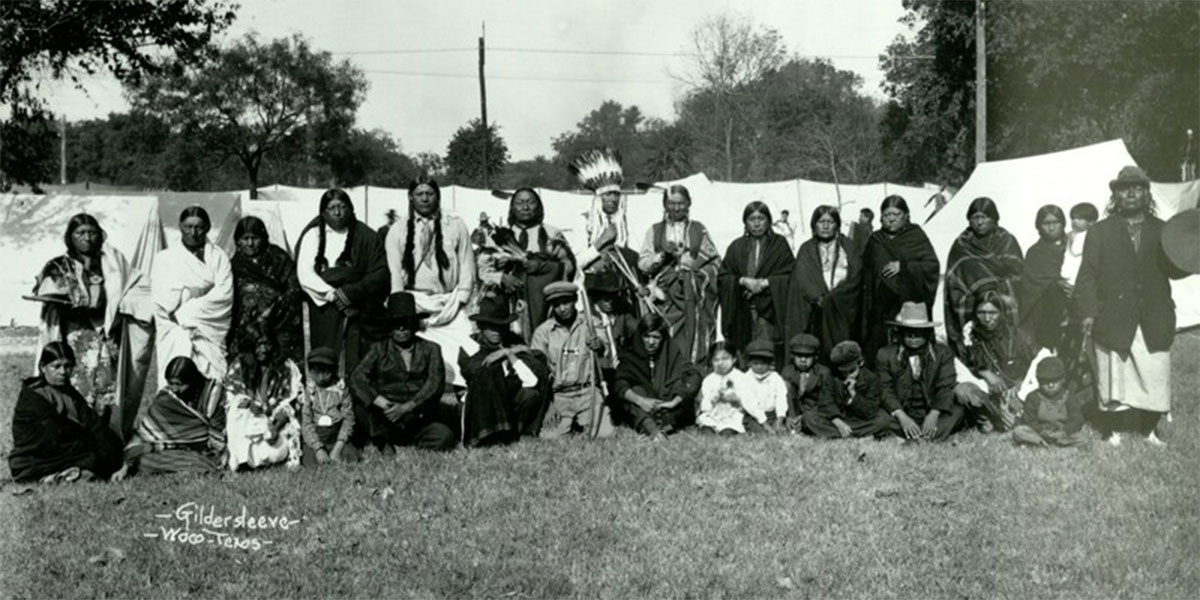Who were the Native Americans in Waco?

If you know anything about the history of Native Americans in what is now Waco, it’s probably that a tribe called the Waco (sometimes spelled “Huaco” or “Hueco”) lived in this area before settlers began moving south and west into Texas.
Native American Heritage Month is a great time to learn about those who lived in Central Texas long before Baylor was established in 1845, or moved to Waco in 1886. By that time, Indigenous peoples had occupied areas along the Brazos River for centuries. Here’s a brief introduction to the groups that, like Baylor, once called Waco, Independence and Central Texas home:
The Waco were a band of the Wichita tribe that arrived in Central Texas in the 1700s. Their society was agrarian, farming such crops such as melons, pumpkins, lima beans and corn. During the late fall and winter, Waco men would leave their villages for extended buffalo hunts. During the 1700s, they also had a lucrative trading partnership with the French. By 1830, however, there was no longer any permanent village for the Waco in this area. As American settlers moved into the area, the Waco were pushed upriver. In 1835, the Wichita (including what remained of the Waco) signed the first of a series of treaties that eventually led to their removal to what is now Oklahoma. Today, descendants of those Waco are part of the Wichita and Affiliated Tribes.
The Tawakoni, another band of the Wichita, were close allies of the Waco. Like the Waco, they spoke a dialect of the Wichita language. The Tawakoni lived in villages across Oklahoma and Texas, with a similar plains-based lifestyle to the Waco. After arriving in Central Texas in the 1700s, they, too, were driven from the area by settlers, joining the Wichita and Waco in treaties that led to their removal to Oklahoma. Today, they are also part of the Wichita and Affiliated Tribes.
The Tonkawa were actually a group of independent bands that came together in the 1600s and 1700s; their name is a Waco term meaning “they all stay together.” Over time, they were pushed south by other Native peoples from Oklahoma into North and then Central Texas. Their men were famous warriors, and the people were nomadic, moving their tipi villages as needed. They were removed to Indian Territory in the 1850s, where their few survivors are still based today.
The Nʉmʉnʉʉ (more commonly known as the Comanche) moved across the plains into present-day Oklahoma and Texas in the late 1600s and early 1700s, gaining the nickname “Lords of the Plains” for their mastery of horseback riding and hunting. A nomadic people, present-day Waco was on the eastern border of the Comanches’ domain; here, they traded with the Waco people, offering protection in exchange for food. In the 1850s, they were exiled to Indian Territory, where many of the Comanche Nation still reside.
The Karankawas largely resided along Texas’ Gulf Coast — semi-nomadic, following food sources with the changing seasons, but with some permanent settlements. They successfully defended their land from European settlers for decades, but by the 1850s, they had largely been either annihilated or assimilated. In recent years, descendants of the Karankawa have formed clans to revive the Karankawan language and culture and to protect their ancestral lands along the coast.
The Lipan Apache came to Texas in the 1600s, ranging at times from the Colorado River to the Rio Grande. A nomadic people, they lived almost completely off the buffalo, and they were among the first Native Americans in Texas to learn to ride horses. A dominant tribe in the late 1600s, they were eventually pressured by the Comanche from the north and European settlers from the south and east. Most of the tribe fled to Mexico in the 1850s; those who stayed in (or who returned to) Texas largely joined Hispanic population in San Antonio and South Texas.
Sic ’em, history lovers!

